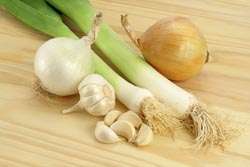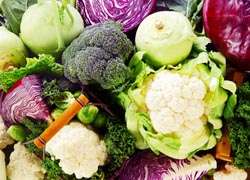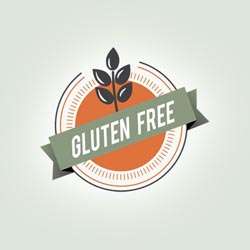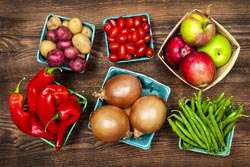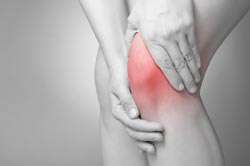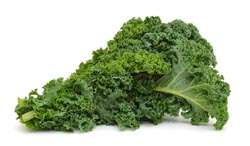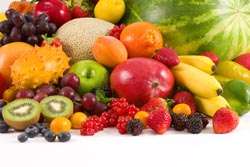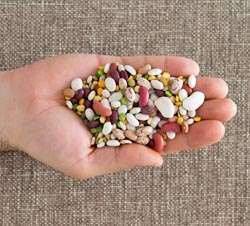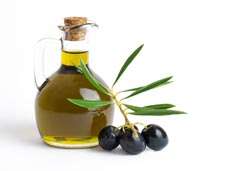Food
Find your care
Our compassionate GI nutrition experts provide outstanding personalized care. Call 310-206-6279 to connect with a specialist.
I have been fascinated for some time by the potential power of the allium family --- garlic, leeks, onions, shallots, chives and scallions. These root vegetables have been revered for thousands of years for their medicinal qualities and savory taste.
Alliums produce a hot taste and pungent smell that comes from a compound called thiosulfinate, which is sulfur based and appears to play a beneficial role in fighting cancer and reducing cardiovascular disease. Another important component in the allium family's arsenal is the ingredient allicin. This powerhouse molecule is antimicrobial and antibiotic, actually used during World War II to treat infected wounds of injured soldiers. Finally, the main antioxidant in allium vegetables, quercetin, appears to rival some of our best anti-cold and flu medications, given its potent antiviral properties.
From a digestive health prospective, the allium family can cause some grief. These powerful antioxidant rich vegetables also contain a sugar molecule called fructan. This sugar is not well broken down by the body and can therefore cause malodorous gas, bloating and changes to bowel habits for some people.
If the alliums lead to digestive unrest for you, consider skipping the garlic and onions and instead go for chives and the green portions of scallions - they have much lower fructan content but still hold all the medicinal qualities desired from the allium family.
September marks the beginning of fall. For those of you with a home garden, this means the time of year to plant cruciferous vegetables such as cabbage, kohlrabi, kale and broccoli. These hearty plants thrive in colder weather and are nutritional powerhouses.
According to the National Cancer Institute of the NIH, cruciferous vegetables are high in lots of antioxidants such as beta carotene, lutein, zeaxanthin as well as vitamins and minerals such as vitamin C and folate. All of these have anti-cancer properties that keep cells from DNA damage, inactive cancer-promoting chemicals, decrease inflammation in the body and can even cause cancer cells to die.
In regards to digestive health, this family of vegetables acts as prebiotics, meaning they help to feed the gut bacteria (probiotics) that are essential for proper digestion. Aim for at least 2 cups of vegetables per day and consider adding some of these healthy cruciferous varieties to the mix:
- Arugula
- Bok Choy
- Broccoli
- Brussels Sprouts
- Cabbage
- Cauliflower
- Collard Greens
- Kale
- Turnips
- Watercress
As we move into the summer months with the summer heat, staying hydrated becomes even more important.
The two biggest questions I hear from patients regarding hydration are:
- How much fluid intake do I need daily?
- What fluids count towards my hydration needs?
How much fluid one needs to drink in a day is tricky. It depends on several factors, including ones age, weight, physical activity level, any chronic conditions (kidney disease, heart failure, edema/ascites), to name a few. For the average healthy adult, the best rule of thumb is multiply your body weight in kilograms (kg) by 35 to get the number of milliliters (ml) you need to drink daily. Example: A 135 lbs person weights 61 kg (135/2.2 = 61). Multiply 61 by 35 = 2148 ml or 2.1 liters daily.
The question of what counts as fluids is much easier to answer: anything that is liquid at room temperature technically counts. This includes juices, milk, sports drinks, coffee, tea, even ice cream and popsicles. However, the best way to get your fluid needs met is with water. Keep in mind that water is natural, it is easily available and, unlike many other beverages, water is calorie-free. So water should be your first choice.
May is Celiac Disease Awareness Month! For those with celiac disease, eating gluten free (GF) is imperative, but how do we eat healthy while living a gluten free lifestyle?
Unfortunately most of the packaged foods on the gluten free market are low in fiber, high in fat and sugar and loaded with excess calories. Here are a few tips to being gluten free the healthy way:
- Pick whole foods as often as possible; focus on a diet filled with naturally gluten free foods such as vegetables, fruits, beans, lentils, nuts, seeds, low-fat dairy (if tolerated), lean animal proteins such as fish and poultry and GF grains (millet, amaranth, buckwheat just to name a few)
- When selecting GF products, look for a whole food as the first ingredient; for example, when purchasing GF bread, make sure the first ingredient is a whole grain instead of sugar or a refined white GF flour such as white rice or corn starch
- Read the nutrition facts - try to purchase products that have 2+ grams dietary fiber per serving, are low in total fat content and modest in calories
For more information on celiac disease and other gluten related disorders, see the UCLA Celiac Disease Program
Organic is defined by the USDA as "food produced by farmers who emphasize the use of renewable resources and the conservation of soil and water to enhance environmental quality for future generations. Organic meat, poultry, eggs, and dairy products come from animals that are given no antibiotics or growth hormones. Organic food is produced without using most conventional pesticides; fertilizers made with synthetic ingredients or sewage sludge; bioengineering; or ionizing radiation."
It can be confusing to know when to spend the extra money and choose organic produce. The Environmental Working Group, or EWG, makes this decision easier! Every year the EWG puts out a list called "The Dirty Dozen," or most pesticide-ridden produce. Since buying organic can be very expensive, whenever possible, purchase the "The Dirty Dozen" in organic form. The EWG also puts out a list called "The Clean Fifteen," or least pesticide-ridden produce - no need to spend extra for organic forms of these foods - go for non-organic.
For more information on both "The Dirty Dozen" and "The Clean Fifteen"
Inflammation is one of the body's responses to harmful stimuli. There are many causes for inflammation. Some are benign, such as when you stub your toe or get a paper cut, and there is initial redness, swelling and pain. These reactions are meant to help protect you from further damage and to start the healing process by bringing nutrient-rich blood to the area. Other types of inflammation are seen in more chronic, or long term, disorders. This means that inflammation occurs for an extended period of time and no longer helps the body, but actually causes harm, such as in enlargement of the heart, excess weight on the body, open sores that bleed or painful swelling of the joints. According to the CDC, 75% of healthcare money is spent on treating chronic diseases. It is estimated that almost 1 out of every 2 adults living in the USA has a chronic disease. Some of the most prevalent chronic disorders are obesity, diabetes, heart disease, stroke and arthritis, as well as digestive disorders such as ulcerative colitis and Crohn's disease. Stress, physical inactivity, genetic predisposition, and exposure to environmental irritants (pollution, secondhand smoke) can all increase chronic inflammation, as can a nutrient poor, pro-inflammatory diet.
My favorite way to describe an anti-inflammatory diet is "eat as close to the earth as possible, choosing as many colors as possible." Studies have shown that a plant-based diet inclusive of adequate daily fruit and vegetable intake reduces risk for chronic diseases such as cancer, arthritis, obesity and diabetes, while high fat, high refined sugar and high red meat diets are more likely to increase risk of these same diseases. Choosing darker, richer colors from our fruits and vegetables is key - the deep reds, purples and greens of these foods contain necessary antioxidants in the form of phytonutrients that are cancer-fighting machines and thus reduce inflammation in the body. Incorporating foods such as fatty fishes (like black cod and salmon), nuts, seeds, legumes, beans, moderate amounts of poultry, red wine and dark chocolate help to create a healthy, well-rounded and balanced anti-inflammatory diet.
You are probably aware that there are two main types of fiber, soluble and insoluble, but did you know they have very different effects on the body and bowel movements? Soluble fiber dissolves in water and acts as a food source for the healthy bacteria that live in your colon. This type of fiber forms a gel in water, making stool softer and easier to pass; it also slows fecal transit time, helps to lower cholesterol and control blood sugar. Examples of soluble fiber include asparagus, broccoli, carrots, apricots, watermelon and oats. Insoluble fiber does not dissolve in water and passes through the large intestine relatively unchanged. This type of fiber helps move waste quickly through the colon. Examples of insoluble fiber include kale, corn, black beans, raspberries and brown rice. For diarrhea, think soluble fiber; for constipation, go for insoluble fiber.
One more thing, if you have hard pellet like stool, instead of packing in the insoluble fiber, try psyllium husk. It will soften the stool. Once the stool is soft, then increase insoluble fiber to get the system moving.
You may have heard that as humans age we need an increased amount of protein. This is indeed true and due to a process known as sarcopenia — the loss of muscle tissue as a natural part of the aging process. According to the National Institutes of Health, sarcopenia can start as early as age 40 with accelerated loss happening between 50-80 years of age. The loss is roughly 1% muscle mass and 3% strength per year, especially when a person is inactive due to illness or sedentary lifestyle.
So how much protein do we need to eat daily to decrease our muscle loss as we age? For the general healthy adult population, a daily intake of roughly 0.8-1 gram protein per kilogram of body weight is sufficient. For example, a 126 lbs. (57 kg) woman in her 30’s would need roughly 46-58 grams daily. For older healthy adults, the recommendation is 1-1.2 grams protein per kilogram of body weight. For that same 126 lbs. woman now in her 60’s, her protein needs would increase to 58-69 grams daily.
Use this calculation (along with advice from your doctor and dietitian) to figure out your protein needs. Then use the chart below to track your current protein intake for two days. If you are not meeting your minimum needs, use the chart to help add to your daily protein intake.
| Food Item (Grams) | Portion Size | Protein |
|---|---|---|
| Plant Forms | ||
| Beans (canned) | 1/2 cup | 6-10(navy are highest) |
| Lentils | 1/2 cup | 9 |
| Peanut Butter | 2 tbsp | 8 |
| Almonds | 10 whole | 2.6 |
| Soybeans, dry roasted | 1/2 cup | 34 |
| Tofu, firm | 1/2 cup | 20 |
| Quinoa | 1/2 cup | 4 |
| Animal Forms | ||
| Cottage Cheese | 1/2 cup | 14 |
| Egg | 8 oz | 6 |
| Milk | 6 oz | 8 |
| Yogurt (Greek) | 6 oz | 15 |
| Beef | 3 oz | 24-28(pot roast highest) |
| Chicken breast / leg / thigh | 3 oz | 24 |
| Fish/seafood (cooked) | 3 oz | 18-23 |
| Turkey Breast | 3 oz | 25 |
Summer evokes images of days at the beach, barbeques with family and friends and, my favorite part, lots of fresh fruit varieties.
In California, the varieties of fruit available this time of year is incredible ---- all types of berries (raspberries, blackberries, blueberries), avocado, watermelon, and stone fruits such as peaches, plums, pluots, cherries, nectarines and apricots. It is easy to go overboard when shopping at the grocery store or farmer's market, and even easier to overconsume --- eating whole punnets of blackberries or bags of cherries.
Unfortunately, this can lead to gas, bloating and loose stool. The reason for the digestive distress is due to certain sugars found in our favorite summertime fruits. FODMAPs are a set of sugars (fructans, galactans, fructose and polyols) that can be poorly digested and absorbed by the body, especially for some with irritable bowel syndrome (IBS). These sugars are found in the stone fruits, avocado, watermelon and blackberries - yikes!
A few tips for enjoying summer fruits without the gut distress:
- Stick to 3 servings of fruits per day; a serving of fruit is equivalent to 1/2-3/4 cup berries, 1 medium sized stone fruit or 1 cup cubed watermelon
- Only eat one serving of fruit at a time; more than one serving per meal could lead to symptoms
- If you have IBS, or feel the summer fruits lead to digestive issues, instead of going for the stone fruits, blackberries or watermelons, try other melons such as cantaloupe or honeydew and berries such as raspberries and blueberries, which are still in season with lower digestive distress sugars
We all heard this classic kid song during our childhood and may wonder, what is it about beans that cause so much gas?!?
Beans contain sugars called galactans (galacto-oligosaccharides or GOS). This sugar molecule is made up of chains of a smaller sugar called galactose. This chain of sugars needs to be broken apart in order to be absorbed and utilized by the body. Normally, sugars are broken down by an enzyme, which acts like a tiny scissor, cutting the bonds that hold sugars together. Unfortunately, the human body does not make the enzyme needed to break down the galactan molecule.
When the body is unable to break a sugar down, it will send it undigested all the way to the large intestine where it can be ushered out of the body as part of the stool. However, our large intestine is filled with trillions of healthy bacteria that do have the ability to break down, or ferment, the galactan molecules. This fermentation causes gas production.
A few tips for eating beans without the toot!
- Use canned - as opposed to the dry varieties, canned beans have a reduced amount of GOS. This is due to the fact that GOS is water-soluble, meaning this sugar loves water. The GOS leaves the bean and migrates into the water, making the water syrupy. Make sure to dump out all of the water and rinse the beans carefully before using.
- Try soaking your dry beans - again, GOS loves water! My favorite technique is to place 1 cup of dry beans in a glass bowl with 2 cups water and leave on the countertop overnight; dump the water out in the morning and replace with fresh water and leave for another 6-8 hours; dump the water once more, add fresh water and cook.
- Take an enzyme pill - many enzymes on the market contain alpha-galactasidase, the tiny scissor that cuts apart the galactan molecule into individual galactose sugars. This allows for absorption and utilization by the body, so no gas!
I admit it, I'm addicted to good olive oil! I research and savor it the way some savor a fine bouquet of wine or extra decadent chocolate. I go to olive oil tasting events, try every kind I can get my hands on to see if it is smooth, tangy, spicy, pungent, floral, thin or rich.
Olive oil has been a staple of the Mediterranean diet for centuries. This region of the world has lower risks for many diseases including heart disease, cognitive diseases and high blood pressure. Some of this benefit is believed to be due to the high phytonutrient or antioxidant properties of the olives. For instance, olive oil contains, just to name a few:
- Squalene - a protective antioxidant that helps to fights skin cancer
- Oleuropein/Oleocanthal - helps with blood flow and reduces inflammation in the heart
- Quercetin - anti-cancer compound also found in onions
Olive oil has long been touted for its health benefits, but something not fully understood is why getting a quality bottle of olive oil is so important to getting those health benefits. There have been several media outlets reporting on less than top quality olive oils coming into the USA. How can you ensure you are getting a good bottle? Here are a few tips to get you started:
- Choose extra-virgin and unfiltered whenever possible - filtering can remove up to 50% of the health benefits from the oil
- Choose bottles that are dark - clear bottles allow in light which can harm the delicate bio-nutrients; so can heat, oxygen and changes in pH, so cook at low temperatures
- Look for the words "early harvest" on the label as well as " processed within hours of harvesting" - early harvest equates to higher nutrient profile and if the olives are pressed within a few hours of harvesting the quality of the end product should be higher
As February is the month of love, flowers and, most notably, chocolate, I thought it would be fun to discuss some of the pros and cons of this beloved sweet treat.
Chocolate, termed the "food of the gods," has been around for over 4000 years, first enjoyed as a bitter beverage by Olmec, Mayan and Aztec cultures in Mexico. Cocoa was introduced to the Western world by the Spanish Conquistadors in the 1500s where sugar was added, leading to the first incantation of our current chocolate beverages, bars and confections.
We know chocolate is delicious, but is it nutritious? The answer is yes and no. Cocoa contains several beneficial properties, most notably catechins. Catechins are a form of flavonol, or antioxidant, that are proven to reduce cardiovascular disease by decreasing plaque buildup in the arteries. Another notable compound in chocolate is anandamide. This fatty acid only occurs naturally in one other plant source, cannabis. Ever wonder why chocolate was so pleasurable and addictive? Now you know!
The cons of chocolate - since cocoa on its own is very bitter, lots of refined sugar is added when making chocolate to increase palatability. Other ingredients such as milk, preservatives and additives increase calories and fat and decrease the health benefits of chocolate.
To get the most from your chocolate, think darker and moderation. Look for chocolate bars with 72% or higher cocoa content (higher cocoa generally equals less added sugar and hopefully higher catechin content) and eat no more than 1-2 squares daily.
